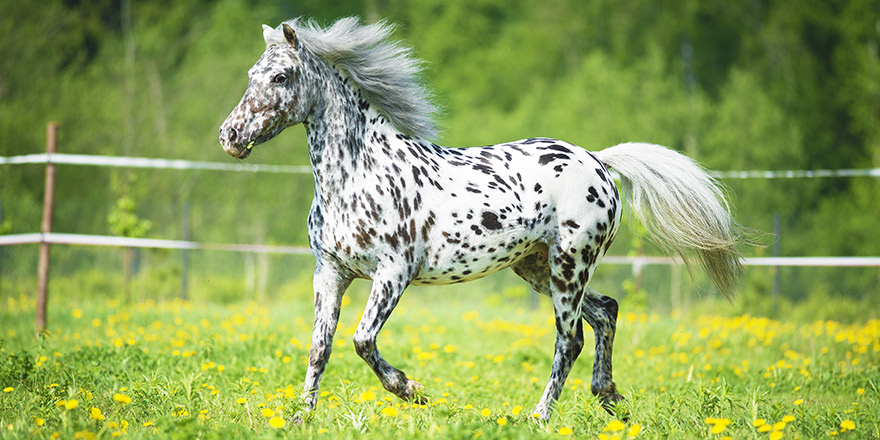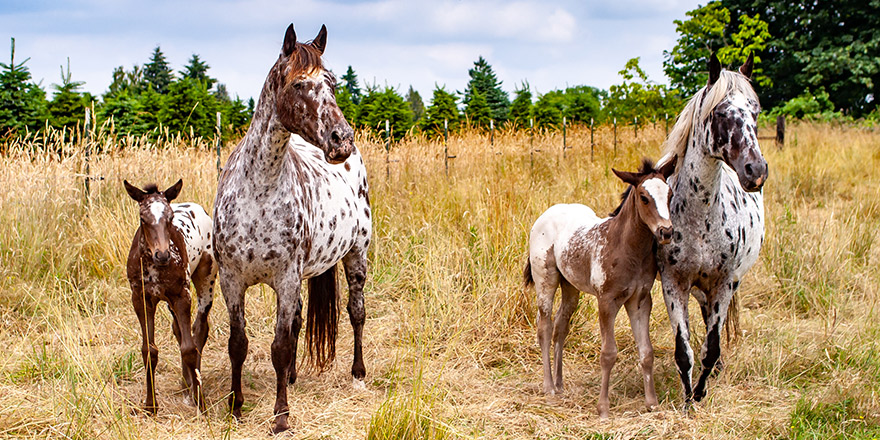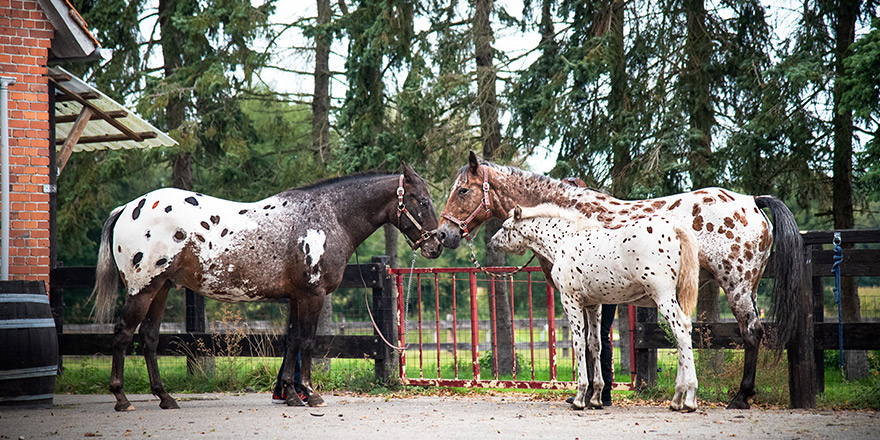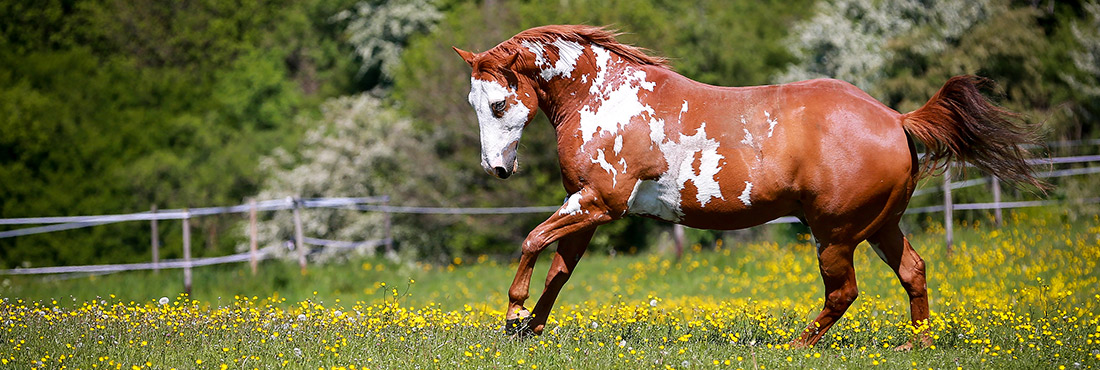Instantly recognizable thanks to their spotted coat, the Appaloosa horse is a versatile breed with a temperament that makes them loyal equine companions. They are also one of six known spotted breeds and boast a number of dotted coat patterns and color variations.
Eager to please and able to turn their hoof to a wide range of equestrian pursuits, it’s no wonder that the Appaloosa is a horse that’s in demand. We look at the history of this spotted stunner and explore just what it takes to care for and get the most out of the endearing Appaloosa breed.
Appaloosa Breed Overview
| Body Type | Height | Distinguishing Features | Life Expectancy | Care Level | Best for |
|---|---|---|---|---|---|
| Compact and muscular | 14 hands - 16 hands | Variety of spotted coat patterns, striped hooves, white sclera | Around 30 years | Moderate | Riders of all levels |
Appaloosa History
Think of the Appaloosa and you will most likely think of the iconic spotted horses made famous in Western movies. But this spotted horse is not a one-off as the Appaloosa is in fact one of six spotted horse breeds. The other five are the Danish Knabstrupper, the Falabella Pony, the British Spotted Pony, the Noriker, and the Nez Perce Horse. The latter is in close relation to the Appaloosa.
It is thought that the spotted horse dates to pre-historic times with cave paintings in Europe showing horses with leopard spots. Similar representations have been discovered in both Ancient Greece and China’s Han Dynasty. Fast-forward to the Middle Ages, spotted horses were valuable gifts given to many of Europe’s royal families.
The predecessor of today’s Appaloosa found its way from Spain to the Americas in the 1500s, when the Spanish conquistadores arrived in the New World. Some of these athletic and striking animals escaped and gradually formed their own wild herds, migrating north to the Great Plains. Some settled around the Palouse River region of southeastern Washington and Idaho, where the Nez Percé tribe recognized the animals’ hardiness and athleticism.
The Nez Perce became skilled horsemen, carefully breeding herds of these strong, striking-looking horses, which became known as the ‘A Palouse Horse’. These hardy Nez Perce horses were the precursors of the modern Appaloosa.
The Nez Perce tribe used their horses for traveling the treacherous trails between eastern Oregon and the Rocky Mountains to their summer camps on the Plains. They were also used to hunt bison, developing speed and a smooth gait to allow their rider an accurate aim while at full gallop.
The Nez Perce War
It was during the Nez Perce War over land rights in 1877 that the native Americans’ horses were captured or shot by the US Army after it recognized the advantage that these athletic horses were giving the tribes. While this almost wiped out the breed, a few of these Palouse horses, however, managed to escape and the Palouse region is still home to herds of wild ‘Appaloosa’.
It wasn’t until the 1930s and an article in the Western Horseman magazine that there was a renewed interest in the Appaloosa breed, which had Quarter Horse bred into it from the late 19th Century. As a result, the Appaloosa Horse Club (ApHC) was formed as a breed registry that oversees strict breeding practices. The continuing popularity of the breed – has meant the Appaloosa Horse Club is now one of the largest horse registries in the world.
As an interesting aside, the Nez Perce tribe started its own horse breeding program in 1994, to restore its own horse breeding tradition. By crossbreeding the Appaloosa with a Central Asian breed called Akhal-Teke, the Nez Percé Horse breeding program has since established the Nez Perce horse as a distinct breed.
More Facts about Appaloosa Horses
Here are just a few more fascinating facts about this spotty breed:
- The Palouse horse – AKA, the Appaloosa – was bred by the Nez Perce tribe to have shorter, sparser tails so they wouldn’t snag in the brush when galloping at speed.
- As a fast horse, the Appaloosa excels at middle distance races. In fact, an Appaloosa set the all-breed record for a 4.5-furlong race, a record that still holds today.
- Born in 1918, a stallion called Knobby, who evaded the U.S government’s confiscation policy, is widely recognized as a foundation sire of the Appaloosa breed today.
- Other ‘celebrity’ Appaloosas include Cojo Rojo, who starred in the 1966 movie, ‘The Appaloosa’ alongside Marlon Brando, and Zip Cochise, who was John Wayne’s steed in ‘El Dorado’.
- The Appaloosa is the officially recognized state horse of Idaho.
- Idaho also happens to be home to the Appaloosa Horse Club, which has registered more than 700,000 Appaloosas since it was founded in 1938.
Characteristics of the Appaloosa

Eye-catching, versatile, and fast, the Appaloosa is a distinct horse that offers the equestrian the chance to take part in a wide range of equestrian sports. And ‘on-the-ground’, this spotted breed has a gentle demeanor that makes the Appaloosa one of the best horse breeds around. But as with all horses, caring for an Appaloosa takes time, commitment, and know-how. Here are the main characteristics of the Appaloosa horse breed you should consider.
Appearance
The Appaloosa horse breed is instantly recognizable thanks to its distinct spotted patterns. There is no one spotted look for this horse breed, as the potential genetic combinations of markings and colors make each one unique. However, all the breed’s spotted patterns are collectively known as the leopard complex as every Appaloosa horse carries the allele of the dominant leopard complex gene. More on this later.
As well as their spotted coat patterns, there are also several other physical characteristics that set this breed apart.
The Appaloosa’s tail and mane are both on the sparse side and are not as dense or luxurious as other horse breeds. Then there is the unusual vertical striping on their hooves, creating a distinct dark and light pattern. Appaloosas can also have mottled skin to create a speckled pattern which is usually found around the muzzle and eyes as well as the genitals. And finally, the white portion of the Appaloosa’s eye around the iris – known as the sclera – is also visible, a trait not seen in any other horse breed.
Size and Body Type
Categorized as one of the light horse breeds, the physical appearance of the Appaloosa is of an athletic, lean animal that is ideal for trail riding, racing, and agility. When it comes to height, they are a mid-sized horse, typically standing between 14 hands/56 inches and 15 hands/64 inches but can be a little larger. A healthy adult Appaloosa should weigh in at 950-1,200 pounds.
An Appaloosa horse body type also shows the influence of the Quarter Horse, the Arabian, and even the Thoroughbred blood. This means the Appaloosa horse breed recognized by the Appaloosa Horse Club typically has a good muscular frame, with powerful hindquarters, which drives their speed, agility, and stamina.
Coat Color and Patterns
The most common base colors of the Appaloosa accepted by the Appaloosa Horse Club include blue roan, red roan, bay roan, palomino, chestnut, black, buckskin, cremello, and dun. They will also often have facial patterns in white, such as a blaze or star as well as white markings on their legs and mottled skin.
Now to the famous feature of the Appaloosa – their spots and colorful coat patterns. And the fact that not all Appaloosas have definite spots. In fact, you can get solid-colored Appaloosa horses, although to be registered with the Appaloosa Horse Club, they need to be blood-typed to confirm that they carry the leopard complex gene.
The Appaloosa Horse Club APHC also recognizes a number of different Appaloosa patterns in their coat, including:
Leopard – with a mainly white body covered in dark spots, this is the clearest example of the ‘leopard complex’ genetic sequencing behind the Appaloosa coat pattern. The leopard pattern can range from lighter spots that give a roan graying effect right the way to distinct dark ‘Dalmatian’ spots against a white coat.
Snowflake – this stunning coat pattern sees the body of the Appaloosa as a dark solid coat with a scattering of white spots or flecks over the body with a concentration on the haunches and hindquarters. This is the reverse of the other coat patterns of dark spots on a white coat, with the base usually a chestnut, dark bay, or black. The result looks like white irregularly scattered snowflakes on a dark background.
Blanket – here the body coat of an Appaloosa is a solid color, with the haunches all-white – known as the classic blanket or snowcap – or white with dark spot speckled (spotted blanket).
Varnish – the varnish roan coat pattern develops over time, with a roan-colored Appaloosa starting out with very little white roaning or flecking. This flecking pattern then develops and spreads with age. This Appaloosa pattern can often be confused with graying or a true roan color.
Marble – another Appaloosa colorway is the marble, which as the name suggests, features white and dark hairs beautifully mingled together to create mottled, marbled coat patterns.
The Appaloosa Temperament
For many, the beautiful Appaloosa horse is the ideal combination between its athleticism and hardiness and its gentle, loyal nature. While it’s important to note that temperament can vary between horses, the Appaloosa is generally recognized as trustworthy and can tend to be human-orientated. This means that they can try hard to please their ‘person’.
The Appaloosa is an extremely versatile horse that is also known for its calmness. However, they can be prone to stubbornness and even aggression if treated unfairly or roughly which means they thrive on thoughtful, natural horsemanship.
Add into the mix their strength and stamina and the level-headed Appaloosa make excellent all-round riding horses that can also step it up a level when it comes to being given a job to do, whether that’s horse racing, show jumping, trail riding, and even as an endurance horse or working herding cattle.
Caring for the Appaloosa Horse

As with any horse, caring for an Appaloosa is a big commitment as they need careful management to ensure all their needs are met and they remain fit and healthy. Here are the key things to consider if you are looking to get yourself a beautiful Appaloosa:
Environment
The Appaloosa is a breed not considered to be high maintenance and can happily live out as a pasture horse. And this is due to the breed’s need to roam and interact with other horses. Even if you plan to stable your Appaloosa you need to ensure they have sufficient daily access to pasture so they can socialize and forage.
Appaloosa horses are better suited to colder weather rather than higher temperatures. Either way, you need to ensure they have access to plenty of water, especially on hotter days to avoid dehydration, as well as minerals, ideally in the form of salt licks. Shade is also important so they will need shelter in their paddock or field. You may also need to rug them during colder, wetter weather and during the winter.
Regular Maintenance
If left barefoot, the Appaloosa will need to have its striped hooves trimmed every 6-8 weeks. If your horse is shod, then their shoes will also need changing roughly every eight weeks, depending on their activity levels and environment.
As the teeth of all horses are continually growing, an annual visit from the horse dentist to check and file their teeth is essential. Younger Appaloosas (under the age of five) should have twice-yearly teeth checks.
Nutrition
The Appaloosa requires the standard equine diet of fresh grass, high-quality hay, and grains, with some fruits and vegetables as cooling, nutritious treats. Depending on their age, health, or workload, they may also need extra vitamins and minerals as a supplement, especially if they don’t have consistent access to fresh pasture.
As all horses are designed to eat throughout the day they are natural grazers, and so forage in the form of hay and fresh grass is a priority. The amount of food, including extra grains and supplements, will then depend on their size and activity levels.
Grooming
The coat of the Appaloosa is a standard length, although their sparse mane and tail are not as thick as many other horse breeds. This means that they are relatively low maintenance when it comes to a grooming routine. A good grooming session a couple of times a week is the best way to keep their coat dirt, debris, and tangle-free, although lighter colored Appaloosas may need more regular grooming. And don’t forget, grooming is a good way to bond with your horse, so shorter daily grooming sessions can also work well.
When grooming your Appaloosa, use the opportunity to check for any injuries or infections and always inspect the underneath of those quirky striped hooves, and use a hoof pick to remove any impacted dirt or stones.
A final, but essential point regarding the grooming needs of an Appaloosa is that their skin can be vulnerable to sun damage, especially if they have exposed pink or mottled skin. To help protect your horse, ensure they have shelter to shade from the sun and consider using a sunscreen, specifically developed for equines.
The Health of the Appaloosa
As a sturdy and robust animal, the Appaloosa is generally a healthy horse and if they are cared for properly, is not generally known for lameness or behavioral issues. However, the breed can be susceptible to certain health problems that can be related to the leopard complex gene:
Sunburn – lighter colored Appaloosas, especially those with the leopard spot pattern or mottled skin are prone to burning easily when in the sun. If left unprotected or untreated, sunburn can eventually lead to skin cancer so taking preventative measures such as sunscreen and providing shelter is essential.
Eye issues – Appaloosas are particularly prone to eye problems, including:
Night blindness – while not usually serious, night blindness can be an issue for some Appaloosas. It is thought the leopard gene causes the condition, which usually develops over several years as a horse age and affects their ability to see clearly after dark or in low light.
Equine uveitis – Appaloosas are also more prone to equine recurrent uveitis than many other breeds. This condition involves an infection of the uveal tract (the middle layer of the eye), causing redness, irritation, and puffiness, which can lead to a damaged retina if left untreated.
Eye infections – as their eyes tend to water, Appaloosas can also be susceptible to general eye irritations and infections. A fly mask, especially during the summer months can help to protect their eyes.
Sight loss – sadly, Appaloosas are also almost eight times more likely to suffer complete blindness, compared to other horse breeds. While more studies are needed, it is thought this is due to genetics.
Buying an Appaloosa Horse

If you are looking for an adaptable horse that’s also a head-turner and has a reliable, loyal personality, then the Appaloosa could be for you. However, you will need to pay more for horses with the more dramatic or highly spotted coat patterns.
In answer to the question, ‘how much do Appaloosa horses cost?’ as a guide you should expect to pay between $1,000 and $10,000 on average for an Appaloosa Horse Club recognized horse. Appaloosas with a competition track record, premium breeding lines, or specific training will most likely cost more. The popularity of the breed also means it is possible to adopt an Appaloosa from a rescue organization.
Whether you are looking to buy or adopt, make sure you follow the best practice rules when obtaining any horse. Always visit the breeder, owner, or rescue center before committing to a horse or handing over any money. You want to see how the horse behaves and interacts and get more information on its history, health, training, and temperament. If you are unsure what you should be looking for, take a more experienced friend or colleague with you. And a veterinary check before finalizing the deal is always a good idea.
Frequently Asked Questions
Appaloosas are well-suited to both Western and British styles of riding, which means there are many activities they can be used for. Their easy-going manner also makes them excellent trail or leisure horses and they are a great addition to any horse loving family.
If you want your Appaloosa to ‘have a job’, then you will be spoilt for choice! The breed is known to make excellent working ranch horses, as well as barrel riding and reining. Or they can excel out on the eventing, cross country, show jumping or hunting field.
Thanks to their generally gentle and trustworthy nature, Appaloosa can be a good consideration for new equestrians, although you will need a good understanding of the essentials of horse care. They are also excellent choices for family homes who enjoy leisure riding as many competent children will also be able to comfortably ride this gorgeous breed. And the beauty of the Appaloosa is that they can then step it up a gear if you fancy trying your hand out on the competitive field or with more sporty activities.
Despite the breed almost being wiped out in the 19th Century, the renewed interest in the Appaloosa from the 1930s means that the breed is no longer rare and is today a thriving and popular horse in the equine world.
The average lifespan of an Appaloosa today is between 26 and 30 years, meaning that as long it is kept well and in good health, this breed is a long-living animal.
Thanks to their strong hindquarters, Appaloosas are considered fairly good jumpers, with a jump that has been described as ‘spring-loaded’! But some Appaloosas have finer legs or narrower hooves which may limit their jumping ability. It all depends on your particular horse.
A snowflake Appaloosa is a dark bodied Appaloosa whose coat is sprinkled with white spots or flecks, which resembles the look of scattered snowflakes. As they age, a snowflake Appaloosa will often develop more of these flecks, which can also increase in size.







